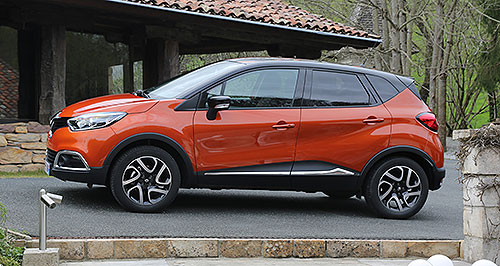News - Renault - CapturRenault defends Captur’s missing airbagsNot quite six: Despite its family focus, Renault has opted to save money and fit only four airbags to its new Captur SUV. Only four airbags for Renault’s Captur mini-SUV, but company says it’s still safe10 May 2013 By BYRON MATHIOUDAKIS in FRANCE RENAULT has defended its decision not to offer curtain or rear-side airbags on the upcoming Captur SUV, even though it is marketed to young families. As with the new Clio supermini, Renault has admittedly cut costs by omitting the third set of airbags, and will instead rely on preventative technologies and a high-strength bodyshell to attain the crucial five-star Euro NCAP rating. In recent times, Renault has prided itself on safety – its Laguna was the first car to receive five stars from Australia’s crash test rating program back in 2001 – and with cars containing six airbags fast becoming norm, the company’s decision is a surprising one. But global project manager Christophe Pejout, speaking in France at this week’s international Captur drive program, said that despite the missing airbags, the Spanish-made crossover was engineered to provide maximum safety in both the European NCAP crash-test laboratory as well as the real world. Mr Pejout’s based his assertions on the presence of (mandatory in Australia) electronic stability control, which can help a car recover from an uncontrolled skid, and stronger than usual body reinforcement using high-strength steels. While admitting that cost constraints always played a role for a vehicle competing in such a price-sensitive end of the market, Mr Pejout said Renault’s real-world crash data research showed a dramatic downturn in side-impact trauma in stability control-equipped vehicles, so engineering resources had moved to improve safety in other problem areas. However, he conceded that in the perfect world curtain airbags would help mitigate injury, but only in some rare situations according to Renault’s data. “It is always a money issue, of course, because you cannot put in every available safety item (in the car in the B-segment),” he said. “It is a question of safety priorities … we put the emphasis in the B-pillar with increased high and ultra-high strength steels, for example. “We look at what is most effective from a money and safety point of view. We don’t communicate this usually … but there aren’t usually many adults in the rear seat (of vehicles the Captur’s size). “Fifteen years ago side impacts were about 50 per cent of all impacts … now it us much reduced (because of electronic stability control). “(But I admit that) ESC remains an answer to many questions but not all of them. “And pedestrian safety is important also … especially in growing markets like China and India. So we must make cars worldwide to protect pedestrians too.”One big focus for the safety team was to provide better pedestrian-impact protection in the front of the car, as evidenced in the underside of the specially designed bonnet. This is of particular relevance in some emerging markets with densely populated cities and lots of foot traffic. Additionally, Mr Pejout said he believed that properly harnessed infants and smaller children in dedicated booster seats were significantly better off without airbags that were either useless or potentially harmful during their violent deployment. Mr Pejout said Renault could fit curtain airbags, although it would need to re-engineer the rear-seat area and move the roof-mounted grab handles to a less effective and more intrusive position.  Read more |
Click to shareRenault articlesResearch Renault Captur pricing
Motor industry news |

















Facebook Twitter Instagram